

Lianne Hennig
I currently run a business with my family, called LILIPILY SPIRIT, stocking (or creating) a range of products we consider enable an empowered life full of inspiration and oriented toward the spiritual. These include such mundane items as teas, herbs, incense, jewelry, books, stickers, posters, cards, t-shirts, etc. We believe that such ordinary things can give people the focus and energy to take the necessary steps toward a better life. We also work with and sell items to do with spiritual ritual, because of our pagan processes. When I'm not busy with those areas of work, I'm a writer, artist, astrologer, self-styled pagan and metaphysician, and carer of an adult disabled son, and of his two lovely daughters when they are with him. Despite some eccentric spiritual philosophies, I can be practical and pragmatic - I don't like to play painful games, so I'll let you know where you stand even if that is confronting. :-) In the past, in this life, I've had many incarnations - business woman, saleswoman, artist, playwright, poet, freelance actor in film & television (Australia), founded and ran an amateur theatre group (Triangle), astrologer, web page designer, lover, wife, mother, grandmother... among other things. I'm an old soul, a devi incarnate, a divine spark in the play of life, any life - meet me on that level. Blessings!
Druid Grove, Order of Bards, Ovates and Druids. Anu. In Sumerian mythology, Anu (also An; from Sumerian *An 𒀭 = sky, heaven) was a sky-god, the god of heaven, lord of constellations, king of gods, spirits and demons, and dwelt in the highest heavenly regions.
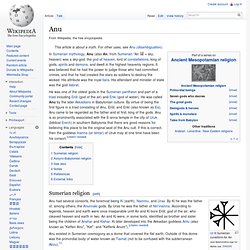
It was believed that he had the power to judge those who had committed crimes, and that he had created the stars as soldiers to destroy the wicked. His attribute was the royal tiara. His attendant and minister of state was the god Ilabrat. Sumerian religion[edit] Ur III Sumerian cuneiform for An(and determinative sign for deities see: DINGIR)
Amun. "Amen Ra" redirects here.
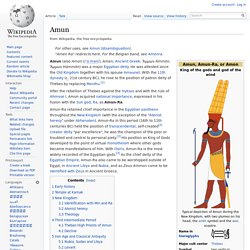
For the Belgian band, see Amenra. Amun (also Amon (/ˈɑːmən/), Amen; Ancient Greek: Ἄμμων Ámmōn, Ἅμμων Hámmōn) was a major Egyptian deity. He was attested since the Old Kingdom together with his spouse Amaunet. Ahura Mazda. Ahura Mazda (/əˌhʊrəˌmæzdə/;[1]), (also known as Ohrmazd, Ahuramazda, Hourmazd, Hormazd, and Hurmuz, Lord or simply as spirit) is the Avestan name for a higher spirit of the Old Iranian religion who was proclaimed as the uncreated spirit by Zoroaster, the founder of Zoroastrianism.
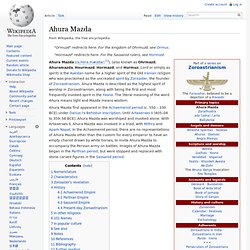
Ahura Mazda is described as the highest spirit of worship in Zoroastrianism, along with being the first and most frequently invoked spirit in the Yasna. The literal meaning of the word Ahura means light and Mazda means wisdom. Ahura Mazda first appeared in the Achaemenid period (c. 550 – 330 BCE) under Darius I's Behistun Inscription. Until Artaxerxes II (405–04 to 359–58 BCE), Ahura Mazda was worshiped and invoked alone.
With Artaxerxes II, Ahura Mazda was invoked in a triad, with Mithra and Apam Napat. Zeus. Name The Chariot of Zeus, from an 1879 Stories from the Greek Tragedians by Alfred Church.
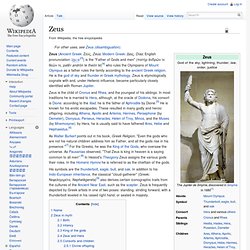
The god's name in the nominative is Ζεύς Zeús /zdeús/. It is inflected as follows: vocative: Ζεῦ / Zeû; accusative: Δία / Día; genitive: Διός / Diós; dative: Διί / Dií. Yahweh. By early post-biblical times, the name of Yahweh had ceased to be pronounced.
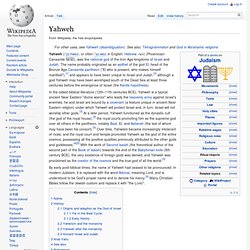
In modern Judaism, it is replaced with the word Adonai, meaning Lord, and is understood to be God's proper name and to denote his mercy. Many Christian Bibles follow the Jewish custom and replace it with "the LORD". Name[edit] The Tetragrammaton in Paleo-Hebrew (10th century BCE to 135 CE), old Aramaic (10th century BCE to 4th century CE) and square Hebrew (3rd century BCE to present) scripts. NOTE: Hebrew is written from right to left. Wōden. Woden or Wodan (Old English: Ƿōden,[1] Old High German: Wôdan,[2] Old Saxon: Uuôden[3]) is a major deity of Anglo-Saxon and Continental Germanic polytheism.
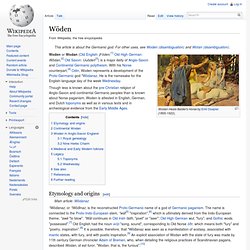
With his Norse counterpart,[4] Odin, Woden represents a development of the Proto-Germanic god *Wōdanaz. He is the namesake for the English-language day of the week Wednesday. Though less is known about the pre-Christian religion of Anglo-Saxon and continental Germanic peoples than is known about Norse paganism, Woden is attested in English, German, and Dutch toponyms as well as in various texts and in archeological evidence from the Early Middle Ages. Vishnu. Vishnu's eternal and supreme abode beyond the material universe is called Vaikuntha, which is also known as Paramdhama, the realm of eternal bliss and happiness and the final or highest place for liberated souls who have attained Moksha.
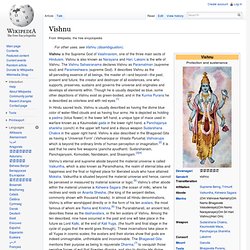
Vaikuntha is situated beyond the material universe and hence, cannot be perceived or measured by material science or logic.[5] Vishnu's other abode within the material universe is Ksheera Sagara (the ocean of milk), where he reclines and rests on Ananta Shesha, (the king of the serpent deities, commonly shown with thousand heads). In almost all Hindu denominations, Vishnu is either worshipped directly or in the form of his ten avatars, the most famous of whom are Rama and Krishna.[6] The Puranabharati, an ancient text, describes these as the dashavatara, or the ten avatars of Vishnu. Name[edit] A 4th–6th century CE Sardonyx seal representing Vishnu with a worshipper.
Týr. Týr (/ˈtɪər/;[1] Old Norse: Týr [tyːr]) is a god associated with law and heroic glory in Norse mythology, portrayed as one-handed.
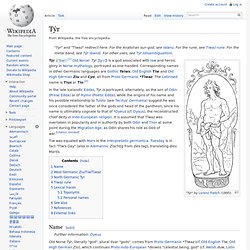
Corresponding names in other Germanic languages are Gothic Teiws, Old English Tīw and Old High German Ziu and Cyo, all from Proto-Germanic *Tīwaz. The Latinised name is Tius or Tio.[2] Name[edit] The earliest attestation for Týr's continental counterpart occurs in Gothic tyz "the t-rune" (𐍄) in the 9th-century Codex Vindobonensis 795.[4] The name is later attested in Old High German as Cyo in the A Wessobrunn prayer ms. of 814. The Negau helmet inscription (2nd century b.c.) may actually record the earliest form, teiva, but this interpretation is tentative. Týr in origin was a generic noun meaning "god", e.g. West Germanic Ziu/Tiw/Tiwaz[edit] Shiva. Shiva (Śiva; /ˈʃɪvə/ listen meaning "The Auspicious One"), also known as Mahadeva ("Great God"), is a popular Hindu deity and is considered to be the Supreme God within Shaivism, one of the three most influential denominations in Hinduism.[1][2] Shiva is regarded as one of the primary forms of God, such as one of the five primary forms of God in the Smarta tradition,[1] and "the Destroyer" or "the Transformer"[3] among the Trimurti, the Hindu Trinity of the primary aspects of the divine.
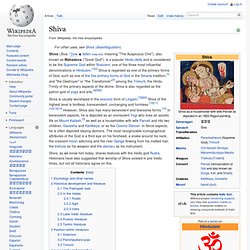
Shiva is also regarded as the patron god of yoga and arts.[4][5][6] Shiva, as we know him today, shares features with the Vedic god Rudra. Historians have also suggested that worship of Shiva existed in pre-Vedic times, but not all historians agree on this. Etymology and other names[edit] Shiva absorbed in meditation, as depicted commonly in Hinduism.
Ra. Ra /rɑː/[1] or Re /reɪ/ (Egyptian: 𓂋ꜥ, rˤ) is the ancient Egyptian solar deity.
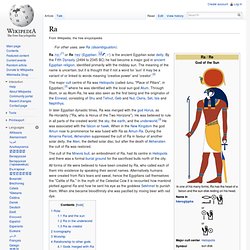
By the Fifth Dynasty (2494 to 2345 BC) he had become a major god in ancient Egyptian religion, identified primarily with the midday sun. The meaning of the name is uncertain, but it is thought that if not a word for 'sun' it may be a variant of or linked to words meaning 'creative power' and 'creator'.[2] In later Egyptian dynastic times, Ra was merged with the god Horus, as Re-Horakhty ("Ra, who is Horus of the Two Horizons"). Quetzalcoatl. Quetzalcoatl /ˌkɛtsɑːlˈkoʊɑːtəl/ (Classical Nahuatl: Quetzalcohuātl [ketsaɬˈko.aːtɬ]) is a Mesoamerican deity whose name comes from the Nahuatl language and means "feathered serpent".[1] The worship of a feathered serpent deity is first documented in Teotihuacan in the first century BCE or first century CE.[2] That period lies within the Late Preclassic to Early Classic period (400 BCE – 600 CE) of Mesoamerican chronology, and veneration of the figure appears to have spread throughout Mesoamerica by the Late Classic (600–900 AD).[3] In the era following the 16th-century Spanish Conquest, a number of sources were written that conflate Quetzalcoatl with Ce Acatl Topiltzin, a ruler of the mythico-historic city of Tollan.
Feathered Serpent deity in Mesoamerica[edit] A feathered serpent deity has been worshiped by many different ethno-political groups in Mesoamerican history. Iconographic depictions[edit] Vision Serpent depicted on lintel 15 from Yaxchilan. Odin. Etymology[edit] Odin's name is formed from "óðr" and the suffix "-inn". Old Norse had two different words spelled óðr, one an adjective and the other a noun. The adjective means "mad, frantic, furious, violent",[3] and is cognate with Old English wōd (hence the anglo-saxon Wōden).[4] The noun means "mind, wit, soul, sense" and "song, poetry".[5] Marduk. Marduk (Sumerian spelling in Akkadian: AMAR.UTU 𒀫𒌓 "solar calf"; perhaps from MERI.DUG; Biblical Hebrew מְרֹדַךְ Merodach; Greek Μαρδοχαῖος,[1] Mardochaios) was the Babylonian name of a late-generation god from ancient Mesopotamia and patron deity of the city of Babylon, who, when Babylon became the political center of the Euphrates valley in the time of Hammurabi (18th century BCE), started to slowly rise to the position of the head of the Babylonian pantheon, a position he fully acquired by the second half of the second millennium BCE.
In the city of Babylon, he resided in the temple Esagila.[2] According to The Encyclopedia of Religion, the name Marduk was probably pronounced Marutuk. Jupiter (mythology) The consuls swore their oath of office in Jupiter's name, and honoured him on the annual feriae of the Capitol in September. To thank him for his help (and to secure his continued support), they offered him a white ox (bos mas) with gilded horns.[10] A similar offering was made by triumphal generals, who surrendered the tokens of their victory at the feet of Jupiter's statue in the Capitol. Some scholars have viewed the triumphator as embodying (or impersonating) Jupiter in the triumphal procession.[11] During the Conflict of the Orders, Rome's plebeians demanded the right to hold political and religious office.
During their first secessio (similar to a general strike), they withdrew from the city and threatened to found their own. Janus. In ancient Roman religion and myth, Janus (Latin: Ianus, pronounced [ˈiaː.nus]) is the god of beginnings and transitions,[1] thence also of gates, doors, passages, endings and time. He is usually depicted as having two faces, since he looks to the future and to the past. Hunab Ku. Enlil. Enlil with his wife, Ninlil. El (deity) El, seated on a throne with lion feet, wears conical horned headdress, a tunic and mantle. He receives gifts from a priest or king or lesser deity. The Dagda. Brahman. Brahma. Baal. Anu. Amun. Ahura Mazda. Ori (Yoruba) Ori is a metaphysical concept important to Yoruba spirituality and philosophy.
Ori, literally meaning "head," refers to one's spiritual intuition and destiny. Kāla (time) Head of Kala carved on top of Kidal temple portal, East Java. Ishtar. Ishtar (English pronunciation /ˈɪʃtɑːr/; Transliteration: DIŠTAR; Akkadian: 𒀭𒈹 Hemsut. Heh (god) Chronos. Zeus. Jupiter (mythology) Horus. Venus figurines. Terra (mythology) Rhea (mythology) Queen of Heaven. Mut. Minerva. Hera. Hathor. Geb. Gayatri. Gaia (mythology) Frigg. Durga. Astarte. Asherah. Yama. Yama (Hinduism) Mara (Hindu goddess)
Azrael. Pluto (mythology) Persephone. Hecate. Hades. Odin. Hel (being) Freyja. Osiris. Nephthys. Anubis. LUGHNASA. Irish Soma. Elysium. Pan (god) Poseidon. Sirena. Agwé. Ved-ava. Mímir. Ægir. Lir. Manannán mac Lir. Llŷr. Varuna. Yam (god) Saraswati. Mazu (goddess) Ganges in Hinduism. Sobek. Tefnut. Oshun. Nephthys. Anuket. Khnum. Varuna. Rahu. Nephthys. Hecate. Erebus. Chandra. Venus (mythology) Triple Goddess (Neopaganism) Rhea (mythology) Minerva.